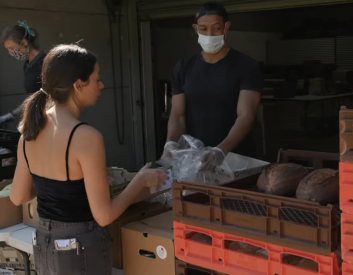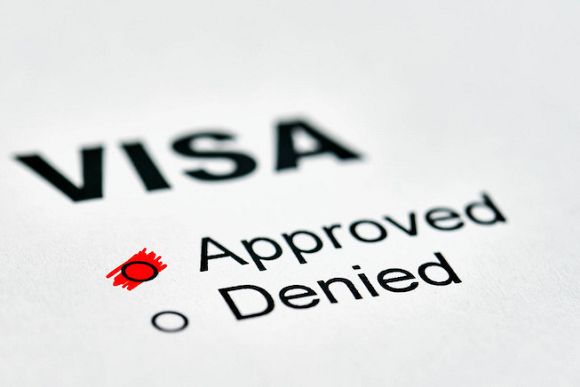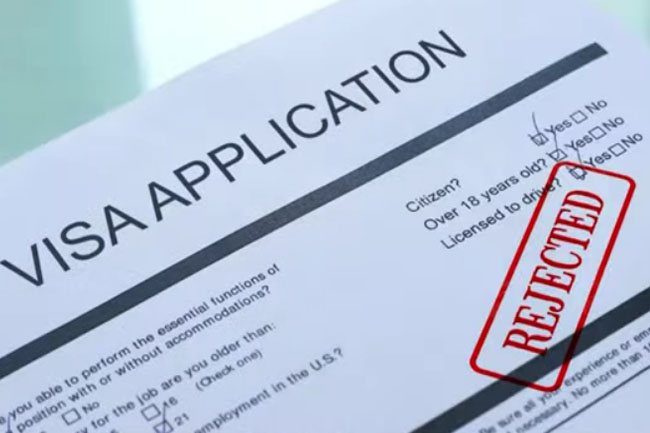The Federal Government is currently facing challenges that could see a crash in student visa numbers, resulting in a costly aftermath, writes Dr Abul Rizvi.
IN THE PAST 40 years, whenever student visa numbers have increased very rapidly, this has come to an end with an almighty crash with far-reaching consequences for both students and education providers. Often, the Australian taxpayer had to pay to clean up the situation.
It happened in 1989-90. Addressing the aftermath of that took almost a decade. It happened again in 2008-09 and again in 2019-20.
While each of these “crashes” was triggered by particular events, the broad ingredients were much the same: a very rapid rise in student visa holders associated with a strong labour market and lax regulation; a high level of fraud in the caseload; a rise in questionable education providers delivering low-quality courses designed to enable students to do little study and mainly work; and education and migration agents misleading students about the cost of living in Australia and the pathways to permanent residence.
In mid-2023, the Albanese Government faces a very similar set of circumstances plus a few additional challenges that past governments did not have to deal with. The question is whether the Albanese Government can manage this situation leading to a “soft landing” or whether we will have another painful “crash”.
The number of students in Australia has over the past 18 months increased at an unprecedented rate after the re-opening of international borders (see Chart 1). The total number of students in Australia at end May 2023 was 610,065. While that was still below the peak of 633,816 in September 2019, that peak will be easily surpassed in the next few months.
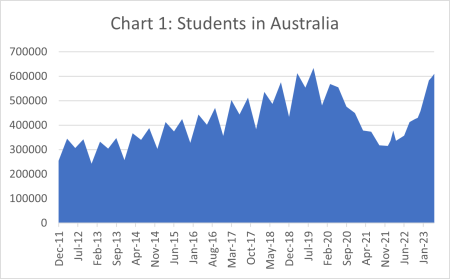
We also need to take into account the number of temporary graduate visa holders (Subclass 485) in Australia as well as the over 100,000 people (mainly former students) now on the special COVID visa (Subclass 408). Most of the people on the special COVID visa have been in Australia for many years but have few pathways to permanent residence or indeed to extending temporary residence. They are in deep “immigration limbo” not dissimilar to the over 74,000 unsuccessful asylum seekers currently in Australia.
The number of temporary graduates in Australia increased rapidly after international borders re-opened and at end May 2023, stood at an all-time record of 194,883 (see Chart 2). This increase is despite record numbers of temporary graduates securing permanent residence over the past 18 months associated with a record skill stream of the migration program.
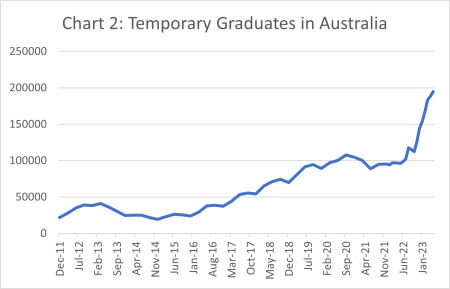
Policy from 1 July 2023 provides for longer duration temporary graduate visas for students who have done a university degree. All things equal, that will accelerate growth in the number of temporary graduates in Australia. Only a relatively small portion of these temporary graduates will secure permanent residence leaving a large portion also in “immigration limbo”, especially if the labour market weakens.
Over the next 12-24 months, many students, temporary graduates and COVID visa holders will apply to undertake (short and cheap) Certificate III courses in aged/disability care and nursing support in order to take advantage of the new Aged Care Labour Agreement.
Offshore student visa applications
The driver of growth in students, temporary graduates and COVID visa holders in Australia is the rate of offshore student visa applications.
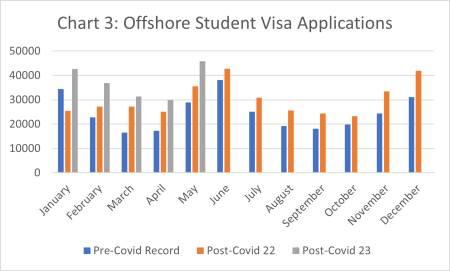
Chart 3 shows that offshore student visa applications from February 2022 onwards have in every month exceeded the record for the same month pre-COVID. In every month to date in 2023, the 2022 records have again been exceeded.
In May 2023, there were 45,784 offshore student visa applications. That is more offshore student visa applications in any month in our history by over 3,000. Much of that will have been driven by unlimited student work rights. It is highly likely offshore student applications in June 2023 were again a new record.
At the same time, the overall refusal rate for offshore student visa applications in 2022-23 to date has been 20.1% compared to 10.5% in 2021-22. The refusal rate for offshore student visa applications in 2022-23 to date has been by far the highest since at least 2005-06. The previous highest reported refusal rate was 16.7% in 2009-10 when the Government significantly tightened student visa policy following the Global Financial Crisis. That led to a major reduction in overseas student enrolments.
The Department of Home Affairs (DHA) as well as some universities are reporting substantial fraud in the caseload.
The combination of record and rising offshore student visa applications, record refusal rates and substantial fraud in the caseload is unsustainable from a visa management perspective. That will be taking up a rising level of DHA resources at a time a range of other caseloads require attention.
What is to be done?
From 1 July 2023, student work rights have again been restricted after the Coalition Government allowed students to work as many hours as they wished. The Albanese Government has allocated additional immigration compliance resources to enforce this but is coming off a very low base as immigration compliance had been given an increasingly low priority under the Coalition Government. The Coalition was strong on visa integrity rhetoric but generally weak on actual follow-up.
Time will tell whether restricted work rights will materially slow growth in offshore student applications including the high level of fraud in the caseload. In the early months, it will depend on the messaging on this from education and migration agents to potential students. Education and migration agents will not want to lose the boom in income they have been earning since international borders reopened.
The reintroduction of restricted work rights will certainly make life for students already in Australia much tougher than it already is given the rising cost of living and high rents. Media reports of the difficulties students are already facing are harrowing. Many would have been misled by education and migration agents about the cost of living in Australia.
A large portion of students will have no choice but to work longer than their student visa allows. That will make them subject to immigration compliance action. Get ready for heart-wrenching media reports of students being detained and removed from Australia for breaching work rights.
The Government is also considering the Parkinson Review recommendation to replace the “genuine temporary entry” requirement which is a major basis for student visa refusals with a “genuine student” requirement. That is a sensible change depending on how the “genuine student” requirement is defined and administered, and when it is implemented. It is unlikely this change will be implemented before November 2023 — most likely later.
The Albanese Government may also tighten risk ratings for processing student visa applications. This can be implemented more quickly but would be strongly resisted by education lobby groups. Higher education lobby groups would be particularly critical as they are facing an even larger exodus of higher education students into short and cheap Certificate III courses in aged/disability care in order to benefit from the Aged Care Labour Agreement.
In essence, most students enter Australia on the basis of a higher education course but large numbers soon leave those courses in favour of a cheaper Vocational Education and Training (V.E.T.) course. They are allowed to do that after six months.
Labor MP Julian Hill has called for “nuclear reforms” to address low-quality education providers. Reforms such as these are desperately needed but Australia’s education quality regulators are notoriously slow to move. He has also called for the regulation of education agents. This has been on the agenda for over 20 years but with no progress.
Another factor in this space will be the huge asylum seeker backlog. Students, temporary graduates and COVID visa holders who run out of visa options may choose an asylum application as the best way to delay departure and temporarily retain work rights. But that would only get them another 2-3 years in Australia with a lawful status. After that, they would join the 74,000 unsuccessful asylum seekers living in the shadows of Australian society.
The major factor hanging over this entire situation is the state of the labour market. A strong labour market can hide many of these issues as finding a job, even in contravention of work rights, will still be possible (mostly cash in hand). A weak labour market, however, would change everything and make students, temporary graduates, COVID visa holders and asylum seekers much more vulnerable to exploitation.
While the Albanese Government has taken some steps to reduce migrant worker exploitation, these are likely to have only a limited impact.
A weak labour market will mean both an increase in migrant worker exploitation as well as an increase in reliance on things such as charities for students to survive. It seems we may be a very long way from a soft landing for student visa policy.
Dr Abul Rizvi is an Independent Australia columnist and a former Deputy Secretary of the Department of Immigration. You can follow Abul on Twitter @RizviAbul.
Related Articles
 This work is licensed under a Creative Commons Attribution-NonCommercial-NoDerivs 3.0 Australia License
This work is licensed under a Creative Commons Attribution-NonCommercial-NoDerivs 3.0 Australia License
Support independent journalism Subscribe to IA.




